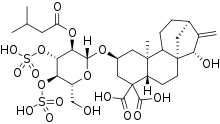Carboxyatractyloside
Carboxyatractyloside (CATR) is a highly toxic diterpene glycoside that inhibits the ADP/ATP translocase. It's about 10 times more potent than atractyloside.[1] While atractyloside is effective in the inhibition of oxidative phosphorylation, carboxyatractyloside is considered to be more effective. As well when carboxyatractyloside is inhibited, it is not reversed by increasing the concentration of adenine nucleotides unlike its counterpart atractyloside. Carboxyatractyloside behavior resembles bongkrekic acid while in the mitochondria.[2]
 | |
| Names | |
|---|---|
| Other names
CATR | |
| Identifiers | |
3D model (JSmol) |
|
| ChemSpider | |
| DrugBank | |
| EC Number |
|
PubChem CID |
|
| UNII | |
| |
| |
| Properties | |
| C31H46O18S2 | |
| Molar mass | 770.81 g·mol−1 |
Except where otherwise noted, data are given for materials in their standard state (at 25 °C [77 °F], 100 kPa). | |
| Infobox references | |
References
- Kedrov A, Hellawell AM, Klosin A, Broadhurst RB, Kunji ER, Müller DJ (January 2010). "Probing the interactions of carboxy-atractyloside and atractyloside with the yeast mitochondrial ADP/ATP carrier". Structure. 18 (1): 39–46. doi:10.1016/j.str.2009.11.009. PMID 20152151.
- Luciani S, Martini N, Santi R (September 1971). "Effects of carboxyatractyloside a structural analogue of atractyloside on mitochondrial oxidative phosphorylation". Life Sciences. 10 (17, Pt 2): 961–8. doi:10.1016/0024-3205(71)90099-3. PMID 4255019.
This article is issued from Wikipedia. The text is licensed under Creative Commons - Attribution - Sharealike. Additional terms may apply for the media files.